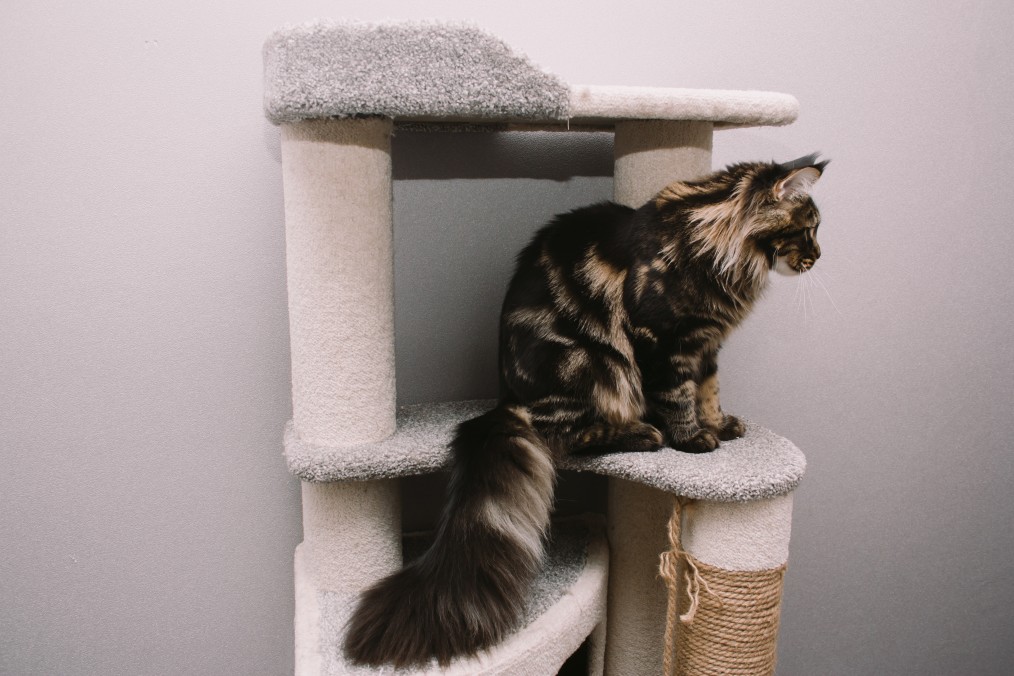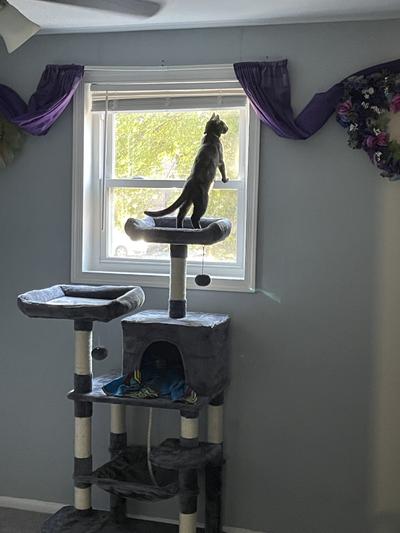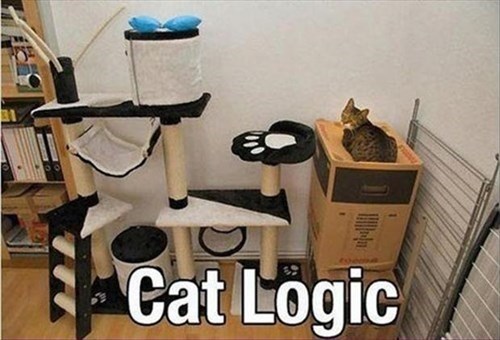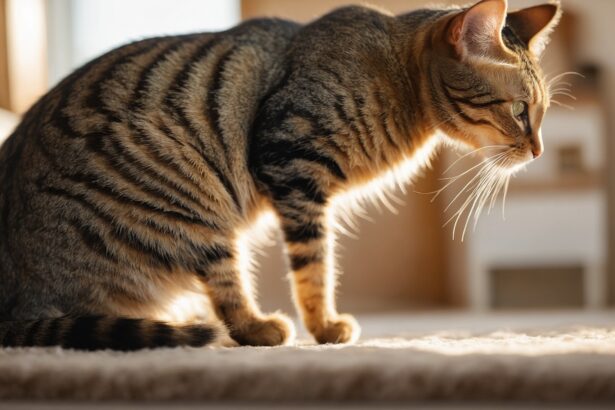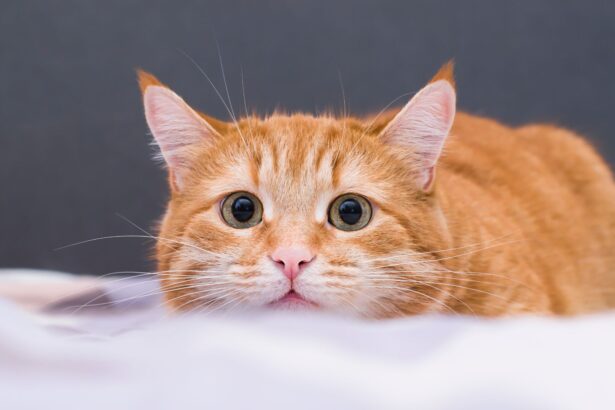Still hesitating to install a cat tree at home? Good news: it’s the perfect ally to channel claws, zoomies and your little explorer’s instincts (and rescue your sofa). Need quick inspo? Browse cat trees with great value for money.
- Scratching: a vital need, not a whim
- A climbing gym for mini athletes
- A high-up hideaway to decompress
- A lookout tower for curious whiskers
- A play zone that really burns energy
- How to choose the right cat tree: key criteria
- The number of cats at home
- Space and placement
- The right height
- Stability and build quality
- Coverings and easy cleaning
- How to spark your cat’s interest
- Where should you place the cat tree?
- Where to buy a good cat tree
- FAQ
Scratching: a vital need, not a whim
Scratching is essential for a cat. It maintains claws, stretches the whole body and leaves a tiny “business card” thanks to scent glands in the paw pads.
Without an approved surface, your furniture becomes the target. A cat tree with sisal posts redirects that instinct to the right place and restores peace at home.
Practical tip: stick skateboard grip tape (or stair anti-slip adhesive) under the base. It’s discreet, super grippy and reduces vibrations on hardwood floors. Want to understand this urge better? Read why cats scratch and act with kindness and efficiency. For daily sofa protection, try these proven ideas: stop furniture scratching.
A climbing gym for mini athletes
Your cat loves to climb, observe, spring into action. A tree offers platforms at different heights to burn energy and strengthen back, shoulders and legs—safely.
Happy indoor cats scale their posts rather than your curtains. Delicious side effect: quieter nights for everyone.
Fun fact: when your cat stretches up to scratch, it’s real “feline yoga” that relaxes the spine and shoulders. That’s why a tall post matters.
A high-up hideaway to decompress
Family life is rich… sometimes a bit much. A cozy cubby or hammock up high becomes a little anti-stress refuge, away from busy foot traffic and curious little hands.
Tuck in a soft blanket that smells like home to help her claim the spot. Cats feel safer when they have a vertical, secluded nook to retreat to.
Watching her wellbeing day to day? Spot the signs of stress in cats to gently adjust her territory. You can also explore our cat tree buyer’s guide if you’re comparing sturdy models.
A lookout tower for curious whiskers
Placed near a window, the top platform becomes the perfect observation deck to watch birds, fluttering leaves and sunbeams.
A tree creates vertical territory that eases multi-cat cohabitation—everyone can perch without crossing paths.
Hesitating between designs? Compare sizes, materials and perks in our guide to the best cat trees and find the one that fits your home.
A play zone that really burns energy
Platforms, tunnels, dangling balls… a cat tree becomes a vertical playground. Chases, hide-and-seek, naps in a row: everyone finds a favorite spot.
After a good session, excess energy drops. Result: fewer midnight antics and more calm cuddles on the sofa.
How to choose the right cat tree: key criteria
The number of cats at home
Plan at least as many beds as cats. For two or more, add extra platforms and cubbies to prevent tension and ambushes.
For multi-cat harmony, consider models with several separate “routes” up and down. It avoids face-offs on narrow posts.
Space and placement
Pick the location before buying: ideally near a window, in a living space, but away from food bowls and the litter tray.
Common mistake to avoid: placing the tree right by the litter “to keep everything together.” Cats dislike the odors and the busy traffic. The tree may be ignored as a result.
Need a clear comparison of formats and sturdiness? Browse our complete cat tree guide. And while you’re optimizing her space, here’s how to choose the best litter for a serene corner.
The right height
At least 1 m for a young, active cat. For seniors, lower tiers (35–70 cm) make access easier without stressing joints.
A post tall enough for a full-body stretch is the secret to a scratching area that actually gets used.
Stability and build quality
Look for a wide base, thick posts and strong screws—essential if your cat is over 5 kg. Light padding on platforms adds comfort and grip.
Bonus tip: if the base is hollow, tuck in a slim gym plate or decorative sand bags to add weight without dismantling. For extra safety on tall models, anchor to a wall with discreet L-brackets.
Coverings and easy cleaning
Choose woven sisal scratching zones; they outlast carpet. Removable cushions or covers = easy wash days.
- Recommended materials: woven sisal, wood, dense fabrics.
- Best avoided: flimsy carpet that fuzzes and wears fast.
- Care: vacuum weekly, rotate posts periodically to wear sisal evenly, and spot-clean fabrics with a gentle textile spray.
Hands a bit wary of clipping time? Here’s how to trim claws safely between scratch sessions. And if you love cozy rituals, discover why cats knead to turn it into a sweet bonding moment.
How to spark your cat’s interest
- Place the tree along her usual route, not hidden in a dead corner.
- Gently rub the posts with a cloth carrying her scent (or yours), then guide her with a feather wand.
- Scatter a few treats on platforms during the first week to create positive associations.
If your cat loves catnip, sprinkle a little on scratching zones and platforms. For best results, see our catnip guide or the English version all about catnip.
Original trick: brew a very light catnip or silver vine “tea,” let it cool, and mist the posts. Many cats respond more to the freshness of a spray than dry flakes.
Where should you place the cat tree?
The sweet spot: near a window in a lived-in room (living room or office). She gets the outdoor show while staying close to the family.
Avoid drafts and cramped corners where she can’t jump or climb down easily. Natural light is perfect for lazy cat naps.
Want calm from floor to ceiling? Explore how to choose the ideal litter to complete her cozy corner.
Where to buy a good cat tree
Pet stores, garden centers and online shops offer a wide choice for every budget.
Online, you’ll often find more sizes and accessories. For instance, check Amazon to spot solid, great-value trees without breaking the bank.
For neat claws between scratch sessions, follow our gentle claw-trimming tips and keep snags at bay.
FAQ
What height should I choose for a cat tree?
Around 1 m for active cats; 35–70 cm for seniors. Prioritize at least one post tall enough for a full-body stretch and platforms your cat can reach easily.
Which scratching material lasts the longest?
Woven sisal generally beats cardboard and carpet for durability. Combined with thicker posts, it provides ideal grip and slower wear.
Wall-mounted or free-standing cat tree?
Wall-mounted saves space and is ultra-stable; great for small homes. Free-standing is easier to move and often includes hammocks and hideaways.
How do I clean a cat tree without damaging it?
Vacuum weekly, brush the sisal, and machine-wash removable covers on cold. Use a mild fabric spray—never saturate the panels.


